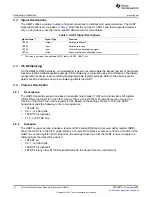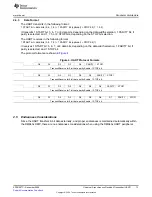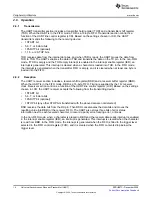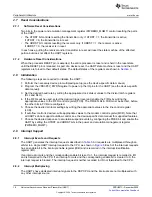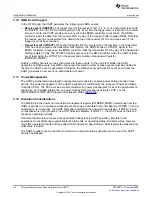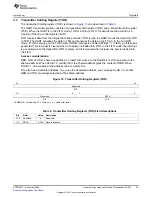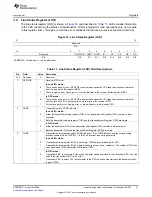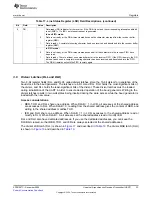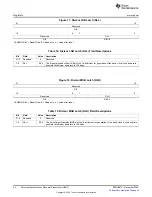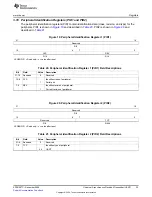
Registers
www.ti.com
Table 11. Interrupt Identification and Interrupt Clearing Information
IIR Bits
Priority
Level
3
2
1
0
Interrupt Type
Interrupt Source
Event That Clears Interrupt
None
0
0
0
1
None
None
None
1
0
1
1
0
Receiver line status
Overrun error, parity error, framing
For an overrun error, reading the line
error, or break is detected.
status register (LSR) clears the
interrupt. For a parity error, framing
error, or break, the interrupt is
cleared only after all the erroneous
data have been read.
2
0
1
0
0
Receiver data-ready
Non-FIFO mode: Receiver data is
Non-FIFO mode: The receiver buffer
ready.
register (RBR) is read.
FIFO mode: Trigger level reached. If
FIFO mode: The FIFO drops below
four character times (see
Table 4
)
the trigger level.
(1)
pass with no access of the FIFO, the
interrupt is asserted again.
2
1
1
0
0
Receiver time-out
FIFO mode only: No characters have One of the following events:
been removed from or input to the
• A character is read from the
receiver FIFO during the last four
receiver FIFO.
(1)
character times (see
Table 4
), and
• A new character arrives in the
there is at least one character in the
receiver FIFO.
receiver FIFO during this time.
• The URRST bit in the power
and emulation management
register (PWREMU_MGMT) is
loaded with 0.
3
0
0
1
0
Transmitter holding
Non-FIFO mode: Transmitter holding
A character is written to the
register empty
register (THR) is empty.
transmitter holding register (THR).
FIFO mode: Transmitter FIFO is
empty.
(1)
In the FIFO mode, the receiver data-ready interrupt or receiver time-out interrupt is cleared by the CPU or by the DMA controller,
whichever reads from the receiver FIFO first.
3.5
FIFO Control Register (FCR)
The FIFO control register (FCR) is a write-only register at the same address as the interrupt identification
register (IIR), which is a read-only register. Use FCR to enable and clear the FIFOs and to select the
receiver FIFO trigger level FCR is shown in
Figure 13
and described in
Table 12
. The FIFOEN bit must be
set to 1 before other FCR bits are written to or the FCR bits are not programmed.
Access consideration:
IIR and FCR share one address. Regardless of the value of the DLAB bit, reading from the address gives
the content of IIR, and writing to the address modifies FCR.
CAUTION
For proper communication between the UART and the EDMA controller, the
DMAMODE1 bit must be set to 1. Always write a 1 to the DMAMODE1 bit, and
after a hardware reset, change the DMAMODE1 bit from 0 to 1.
26
Universal Asynchronous Receiver/Transmitter (UART)
SPRU997C – December 2009
Submit Documentation Feedback
Copyright © 2009, Texas Instruments Incorporated

